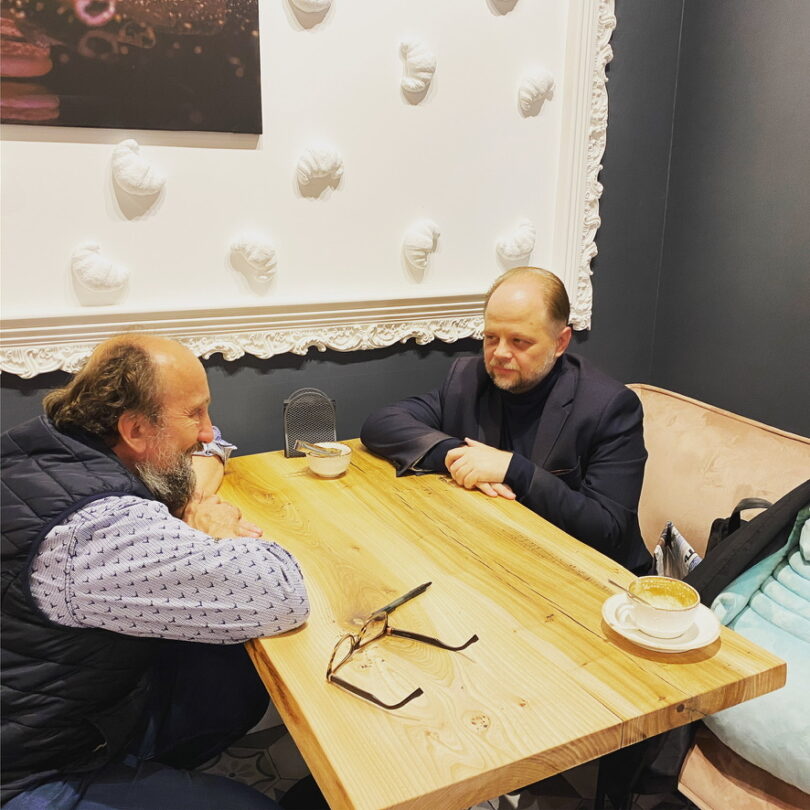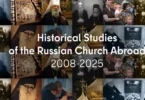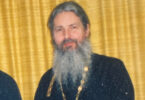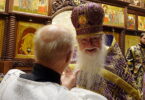Doctor of Historical Sciences Andrei A. Kostryukov, Leading Researcher of the Department of the Contemporary History of the Russian Orthodox Church at St. Tikhon Humanitarian University (Moscow). Prof. Kostryukov is the world’s leading historian of the Russian Church Abroad. He analyzes its history in his monographs. The publishing house of St. Tikhon University has published four volumes dedicated to the ROCOR’s history from the beginning of the 1920s until 1985, and the fourth came out of the press after this interview. Dr. Kostryukov is currently working on the next volume, and I hope that he will be able to go to Holy Trinity Monastery to work in the archives. This interview was recorded “live” in Moscow on September 14. 2021.
Protodeacon Andrei Psarev, February 4, 2022
Andrei Alexandrovich, I am glad to have this opportunity to converse, let alone to record an interview, since this happens very rarely. Our previous interview was recorded in 2009, when your monograph about the Russian Church Abroad came out. And since then, from 2009 on, what additional works on the history of the Russian Church Abroad have come out?
The book Russkaia Zarubezhnaia Tserkov’ v pervoi polovine 1920-kh godov [The Russian Church Abroad in the first half of the 1920’s] came out by 2009. After that three more books on the Russian Church Abroad came out — Russkaia Zarubezhnaia Tserkov’ v 1925 – 1938 gg. [The Russian Church Abroad from 1925 to 1938], Russkaia Zarubezhnaia Tserkov’ v 1938 – 1964 gg. [The Russian Church Abroad from 1938 to 1964], and, just now, Russkaia Zarubezhnaia Tserkov’ pri mitropolite Filarete (Voznesenskom) [The Russian Church Abroad Under Metropolitan Philaret (Voznesensky)]. Also, my lectures on the history of the Russian Orthodox Church were published in 2018, in which a separate large chapter is devoted to the history of the Russian Church diaspora, as well as three books on Archbishop Seraphim (Sobolev), a hierarch of the Russian diaspora. Priest Alexander Mazyrin and I wrote a book on the relationship between the Russian and Constantinople Churches in the twentieth century. My part of the book dealt with Russian emigration.
You are going to give a talk at the conference in Serbia regarding the laity movement in the Russian Church Abroad. I was happy with that talk, and when it was translated into English it drew much interest. You could be a pioneer in researching the subject of conciliarity. I have in mind the adaptation of the legacy of the 1917-18 Council in the Russian Church Abroad since the laity of that Church who spoke out against strong hierarchical authority cited precisely the legacy of that council. In one way or another, the discussion revolved around that council. In your first monograph, you indicate that in 1923 the Bishops’ Council ruled against a supreme church council consisting of laity and priests. In other words, would you agree that the Russian Church Abroad ended with a strong hierarchical element at the expense of representation by the entire body of Christians?
Yes, I constantly emphasize that the decisions of the Local Council regarding church administration were applied neither in the Russian Church during the Soviet years nor in the Russian Church Abroad. In the case of Russia, that is totally understandable. There was persecution and the government allowed councils to take place only with handpicked personnel that were obedient and predictable. How on earth could you set up any kind of supreme church authority? As for the Russian Church Abroad, one would think that all of the conditions for conciliarity were in place. Nonetheless, the conciliar system wasn’t applied here, either. To a great extent, this happened because laymen and the white clergy tried to implement political decisions already in the first years of the Russian Church Abroad. To a certain degree, the dominance of the hierarchical system helped its preservation. We know the kinds of troubles that took place, in the North American Metropolia and Metropolitan Evlogy’s Exarchate for instance, due to attempts to join them to the Moscow Patriarchate. Both at the 1946 Cleveland Council and in Paris in the spring of 1945 passions were at a boiling point, and these two bodies were on the verge of splitting apart. To a great extent, this was caused by active and impulsive laymen who had come to believe that persecution of the Russian Church had ceased. And we know that there were Soviet secret agents among the laity. It was much simpler to plant them among the laity. These individuals took an active part in these councils and simply outshouted the balanced views of hierarchs and priests. As for the Church Abroad, having removed the clergy and laity from its administration, it was relieved of such problems for a while.
I constantly emphasize that the decisions of the Local Council regarding church administration were applied neither in the Russian Church during the Soviet years nor in the Russian Church Abroad
But other problems developed. In the fifties and sixties power was concentrated in the Bishops’ Synod. Its major role was played by individuals living closest to New York, in other words around Metropolitan Anastasy (Gribanovsky). The same happened with Metropolitan Philaret (Voznesensky). A group of church figures who actually made all of the decisions were concentrated around him. These were Archbishop Seraphim (Ivanov), Nikon (Rklitsy), and Protopresbyter George Grabbe. And it turned out that the chancery became dominant, with Father George playing a leading role. Of course, this led to distortions. Protopresbyter George Grabbe had his own ideas about church administration, and this group’s ideology amounted to the preservation of the ideals of “Holy Russia” outside Russia. This led to self-enclosure, excessive conservatism, and, naturally, led to protests. I have in mind, first of all, Archbishop John (Maximovich), who spoke out in favor of the openness of the Church Abroad to the entire world, of conciliar administration, and was even prepared for definite ritualistic and canonical compromises for the sake of the higher idea of bringing the Orthodox faith to people.
Another problem with the dominance of the Synodal Chancery was that the administration started pandering to abuses. For instance, Archbishop John, Archbishop Theodosius (Samoilovich), and other hierarchs complained about serious problems in the administration. Various misunderstandings started arising locally. The fifties to the seventies was a period of constant and lengthy local conflicts. South America had its own conflict, and Australia had a serious and very difficult conflict. And, finally, there was the so-called revolt of the laity in the United States. To a certain extent, these misunderstandings had to do with an attempt to counteract the dominance of the Synodal Chancery. It is understandable that those doing the counteracting also often went too far, and as a result, the Church Abroad found itself on the verge of being split apart in the sixties. Of course, everything was smoothed over, later on, the conflicts went away, but the Church Abroad never did return to the administrative system that had been worked out by the Local Council. It is hard to say whether this was good or bad since too little time has passed to make an assessment. But on the whole, we can still say boldly that the incorrect administrative system of the Church Abroad prevented its joining the Moscow Patriarchate in the early nineties. And if this reconciliation had happened then the Russian Church Abroad could have joined under more favorable conditions and could have attained more serious concessions.
Therefore I feel that what is most important now is not the introduction of mandatory Local Councils but the opportunity of normal development of diocesan and parish life, the creation of brotherhoods, canonical trials independent of the hierarchy, and the opportunity for clergy and laity to speak openly about problems in church life without fear of being penalized for their boldness.
Thank you, Andrei Alexandrovich. After all, one of the features of the 1917-18 Council was precisely the factor of representation. And we see that in the “Position on the Diocesan Council” it is stated that the bishop rules a diocese, either with the collaboration or together with the Diocesan Council. I don’t recall the exact formulation, but this feature is absent in the “Position on the Russian Church Abroad.” The bishop already rules alone. The Diocesan Council has those privileges which the bishop bestows upon it. But now the American Church and the Paris Archdiocese follow the decisions of the 1917-18 Council much more closely regarding the representational factor. Just as in the Russian Orthodox Church our All-Diaspora Council is called by the Bishops’ Council whenever the need arises, while in the American Church the All-American Council gathers regularly and is definitely representational. It seems that in this respect a correction or revision of the 1917-18 Council’s decisions took place.
As far as I know, the All-Diaspora Councils do not have the authority to make final decisions. The 1921 Karlovci Council had such authority to make final decisions, but subsequent All-Diaspora Councils had more of an advisory function and became forums that decided nothing in the final analysis. The final vote belonged to the Bishops’ Conference. And again, it is difficult to say if this was good or bad. A very serious problem here is the low education level of the laity and the bottom monastic layer. This leads to the spread of superstition, the growth of eschatological experiences, and so on. We have observed all this repeatedly, not only in the emigration but also in Russian history. We recall how a group of activists attempted to impose the canonization of doubtful figures such as Ivan the Terrible and Rasputin. And we recall how the Church was being egged on go into schism over TINs[1] and bar codes. Right now something similar is happening with regard to the nonacceptance of vaccines. Obviously, if such people will appear at councils nothing good will come of it. Let me remind you that in the year 2000 the decision was made to change the Local Council of the Russian Church to the Bishops’ Council. Such a problem has not yet disappeared, and we don’t know when everything will become normal. Emigration has its own problems, and I don’t believe that it is now time to change the administrative system according to the models indicated by the Local Council of 1917. I am afraid that there would be more problems. Therefore I feel that what is most important now is not the introduction of mandatory Local Councils but the opportunity of normal development of diocesan and parish life, the creation of brotherhoods, canonical trials independent of the hierarchy, and the opportunity for clergy and laity to speak openly about problems in church life without fear of being penalized for their boldness.
In one of his last talks, Metropolitan Laurus, speaking to a conference at the St. Tikhon Humanitarian University, happened to mention that a vicious cycle occurs when the laity does not get educated, and, correspondingly, cannot participate fully. And their participation ends up, as you said, counterproductive. Therefore this is a big problem. The people of God need to be told of their place in the Church, their service, their collaboration, we could say, with the clergy, and to engage in this educational activity in their Christian dignity, counteracting any extreme currents.
What more can be said? I totally agree with Vladyka Laurus.
Andrei Alexandrovich, your name is closely associated with works on Archbishop Seraphim (Sobolev). And I regard him as a rather rigid hierarch. At the same time, I am sympathetic toward Father George Shavelsky, even if we compare the Stavropol Council, which he conducted, with the 1921 Karlovci Council, where he was absent. After all, the Stavropol Council, even in the complex conditions of the Civil War, tried to be outside politics as much as possible. But ideology is already a very strong presence in Vladyka Seraphim. Please clarify this issue.
I would like to start by saying, first of all, that our Church is capacious and is headed by Christ. It is wrong to divide ourselves into parties, on those “of Paul” and “of Apollos.” The Church has always had room for followers of Saint Nilus of Sora and of St. Joseph of Volotsk. And there was room for representatives of various theological schools and various viewpoints.
And among monks there were those who loved life and were affable and those who were strict and withdrawn, interacting with no one. Nonetheless, there were saints among both kinds. Even more so, diversity of viewpoints is allowable when it comes to political issues. The democracy of Great Novgorod was no obstacle to the growth of holiness. Neither were the Land Assemblies, which played the role of a kind of parliament in pre-Petrine Russia. Finally, there were plenty of saints under the absolute monarchy. And a Christian has the opportunity to defend those viewpoints that are dear to him, if they don’t have to do, of course, with totalitarianism and “cannibalistic” ideologies. It is another matter that the Church must distance itself from political struggle, and Father George Shavelsky did really strive toward that. But his words hardly carried weight in the emigration, for a sharp redirection took place there, whether we like it or not.
Archbishop Seraphim (Sobolev) was a monarchist, and there was no canonical violation in this, especially since he grew up under the monarchy and regarded it as the best political arrangement. As far as rigidity is concerned, I feel that this is an exaggeration. Yes, he stood up for the old calendar and spoke against the ecumenical movement. However excessive strictness was attributed to him in the nineties, In the context of the struggle against the violations and extremes regarding heterodoxy Vladyka Seraphim was taken up as a banner, and certain groups even tried to posthumously present him as an ideologue of “zealot” currents, for instance, in Bulgaria and Romania. It was from there that the view of Archbishop Seraphim as an irreconcilable obscurant originated.
Actually, this is totally incorrect. All it takes is to read his works and letters, and reminiscences about him. Yes, he was a great apologist of Orthodoxy, but he never went as far as fanaticism. As an example, the Russian Church Abroad was in communion with churches serving according to the new style and allowed as exceptions serving according to the new calendar in countries where it was officially accepted. Vladyka Seraphim did not object to that.
Let us consider now the 1948 Moscow Conference, in which Archbishop Seraphim took part. At times there are those among us who try to present this conference as a standard of conservatism. Actually, that was not the case, and we should rejoice that a union with the Non-Chalcedonians did not take place there, which had initially been planned by the Soviet leadership.
Regarding the calendar, the 1948 Conference made the decision that local churches would choose the new calendar themselves. So the resolution coincided with the decision of the so-called “All-Orthodox Congress” held in 1923 in Constantinople. And Vladyka didn’t object, openly at least, against such a decision.
When it comes to ecumenical relations we need to distinguish between fraternization with everyone who comes along and theological dialogue. Archbishop Seraphim censured the former but allowed the latter. We know that the Church Abroad took part before the Second World War in theological dialogue with the Malabar Church, with Non-Chalcedonian bodies. Vladyka Seraphim himself allowed the creation of a pan-Orthodox front to combat godlessness at the 1921 Karlovci Council. So this hierarch was not an extremist. And division or schism due to disagreement with church leadership was generally unthinkable for him as a person of pre-revolutionary formation.
Was there also something personal? Here I am, spending a large part of my life on Archbishop Leonty of Chile. I don’t know how he regards me from there, but I regard him as someone I know well. And I think that something about Vladyka Seraphim probably gained your personal favor or attracted you. After all, it didn’t simply happen that you found him on your research radar and went to work on this.
My initial favorable disposition toward Archbishop Seraphim (Soblolev) had to do with his anti-ecumenism. When individual representatives of local churches prayed together not only with the non-Orthodox but with non-Christians, Vladyka Seraphim’s position was very important. This was a breath of fresh air. Furthermore, he was known as a miracle worker, and in Bulgaria, he is likely to be the most venerated saint. Crowds visit the crypt where he is buried and constantly receive help.
And, of course, his kindness was endearing, as well as his spiritual path and his spiritual children. That was Archpriest Vsevolod Shpiller, who was instrumental in the creation of the St. Tikhon Orthodox University and was insightful, refined, and thoughtful. And there were also Bishop Parthenius of the Bulgarian Church, Archimandrite Panteleimon (Staritsky), and Nun Casinnia (Vezenkova). His spiritual children were good, outstanding people. The tree is known for its fruits.
Researching his life brought out yet another problem — the fact that his unwise followers simply concealed and still conceal his position on certain issues.
Do you have in mind Bishop Photius (Siromakhov) of Triaditsa, of the Old Calendar Bulgarian Church?
Yes, that includes his followers in the Bulgarian Old Calendar Church. For instance, they like to publish his speeches regarding the calendar and the ecumenical movement. At the same time, they conceal his report regarding the Anglican hierarchy. And yet this report was featured at the 1948 Moscow Conference, and it was there that Vladyka Seraphim showed himself to be a supporter of theological dialogue. He was prepared in principle to recognize the Anglican hierarchy as well but felt that it was still necessary to figure out under what conditions this would be done. So he was prepared for concessions that didn’t involve principles.
Vladyka Seraphim was consecrated as Bishop of Luben in October 1920, but he never made it to Lubny. He left Russia but didn’t abandon his Bulgarian flock. Was he able to emigrate? And how did his relationship with the Moscow Patriarchate turn out?
Father Seraphim was consecrated as Bishop of Luben, Vicar of the Poltava Diocese. That was his exact title, although “of Lubny” would have been more correct since that was the name of the city. He was consecrated in the Crimea in the hope that Poltava would be liberated from the Reds. But that didn’t happen. Bishop Seraphim did really leave Russia, but he can hardly be blamed for that. In the first place, the great bishops, such as Athanasius of Alexandria, Gregory the Wonderworker, and others left their countries during persecution. In the second place, Vladyka Seraphim, as Vicar of the Poltava Diocese, did not have his own flock in the Crimea.
His title was then changed by Patriarch Tikhon to Bishop of Boguchar, a town in the Voronezh Diocese. Possibly, this title change had to do with the fact that during the Civil War Patriarch Tikhon had planned to consecrate Vladyka Seraphim for Voronezh as a vicar, but that didn’t happen.
After the Second World War Archbishop Seraphim was accepted into the Moscow Patriarchate. He could have gone to the West in 1944, but he chose not to do so, explaining it by an unwillingness to abandon his sizeable flock. The other factor was that he also did not wish to end up under the influence of the Soviet regime and didn’t dismiss the possibility of transferring to the Bulgarian Church. But he still chose to join the Moscow Patriarchate. Nonetheless, he continued to refer to the Soviet regime as satanic, and, having visited his homeland in 1948, came to the following conclusion: “Not a single corner remained undefiled.”
Do we know any interesting facts about his visit to Moscow?
Vladyka was in the Soviet Union only once in 1948, staying in Moscow and Sergiev Posad. The delegates of the Moscow Conference also had the opportunity to choose other places to visit. Vladyka Seraphim chose Ryazan, where he was born and received his education. Besides Ryazan, he also went to the village of Gorodishche, which was apparently also connected with his childhood. The recently departed church archaeologist Sergei Beliaev, who was a child at the time, saw him in that village and at one point shared his reminiscences. According to Beliaev, Vladyka was unlike any of the hierarchs whom he had ever seen. He gave the impression of an unearthly individual.
Your book about the Church Abroad under Metropolitan Philaret (Voznesensky) has just been published. I don’t know if any other historians have dealt with this period. Have there been academic attempts to make sense specifically of the period of Metropolitan Philaret?
Such an attempt was undertaken by Nun Cassia (Senina). Her book, entitled Stolp ognennyi [A Flaming Pillar] is frank, and the author cannot be accused of dishonesty. The documents that are cited there are also very interesting. This also deals with the “revolt of the laity” in San Francisco and the opposition of the Bishops’ Council to Archbishop John (Maximovich), whom the leadership of the Church Abroad was even planning to bar from serving.
But this book is still largely hagiographic.
Yes, I agree. As far as analyzing this period of the history of the Russian Church Abroad is concerned, and gaining an understanding of it, unfortunately, no one had done any work on the level of producing a research monograph. There are only articles, including yours. I have also used them for my book.
I agree with the view of Bishop Basil (Rodzianko) that divisions were even beneficial in the conditions of persecution. He gave the example of the Serbian Church, which was torn apart by various nations, was divided up into jurisdictions, but once the nation united at the start of the twentieth century the Church also became united.
Do you have any conclusions or thoughts of a general nature regarding Orthodoxy after researching the history of the Church Abroad? Has there been any understanding of a more general nature that you can share?
My general conclusion is that division in the Church is often not schism. I will repeat here the words of St. John Maximovich that making grace dependent upon jurisdiction is a “Latin heresy.” There have been unpleasant moments in the history of the Church with conflicts and divisions, followed by reconciliation. We simply cannot take sides in such conflicts. We know that the Priest Martyr Kirill (Smirnov) said that church life during the Soviet years could not transpire according to the letter of the canons. I cannot help agreeing with Solzhenitsyn, who said that no one can claim one hundred percent canonicity in the twentieth century in the context of the divisions created by the Communist regime. We need to remember that and not play by the rules imposed by the Bolsheviks but should rise above all these numerous squabbles and regard them without prejudice.
Furthermore, I agree with the view of Bishop Basil (Rodzianko) that divisions were even beneficial in the conditions of persecution. He gave the example of the Serbian Church, which was torn apart by various nations, was divided up into jurisdictions, but once the nation united at the start of the twentieth century the Church also became united.
In the conditions of the Communist takeover of power in Russia such a division of Russian Orthodoxy was a forced necessity. The methods undertaken by Metropolitan Sergius (Stragorodsky) to preserve the Church at home would have failed outside Russia. And the position taken by the Church Abroad was impossible in the Soviet nation. With this in mind, I have no problem with the position taken by the metropolitans of the North American Metropolia and the leadership of the western European Archdiocese. They could not bow down before the Soviet beast, but neither could they accept the patriotic positions of the Russian Church Abroad. In America, for instance, a specifically American national Orthodoxy was being planted. The Church is above such divisions. Let me remind you of the words of St. Dimitri of Rostov. Speaking of the conflict between the Apostles Paul and Barnabas, he wrote that the division between them became providential so that acting separately they would bring more people to Christ. And this was repeated in the twentieth century.
Thank you, Andrei Alexandrovich. We can stop on this note. Thank you for a wonderful discussion. This is not just politeness. I had a discussion with you precisely through this interview.
Conducted by Deacon Andrei Psarev
[1] Taxpayer Identification Numbers, the Russian equivalent of Social Security Numbers [trans.].











This is truly a momentous and historically valuable undertaking at a most opportune time in the history of the Orthodox Church.
Fr. Alexander, bless! What undertaking are you referring to?
Are these volumes of ROCOR history of Prof. Kostryukov available at the Holy Trinity Jordanville bookstore?